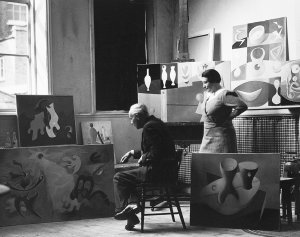1892-1984
< BACK
Paule Vézelay was born in England in 1892, but by the 1930s she had become an active member of the Parisian avant-garde after moving to France and adopting the name Paule Vézelay. She lived for several years with the Surrealist artist André Masson, and mixed with many of the most significant artists of pre-war Paris including Kandinsky, Miro, Mondrian, and her great friends Jean Arp and his wife Sophie Tauber-Arp. Her work is represented in museums and public collections in Britain and abroad including Tate; the British Museum; the Imperial War Museum; the National Portrait Gallery, London; the Victoria and Albert Museum; the Ashmolean Museum, Oxford; the Kunst Museum, Basel; the Australian National Gallery; and the Arts Council of Great Britain.
Vézelay was invited to join the group Abstraction-Création in 1934 and exhibited in several significant pioneering exhibitions of non-figurative art in France, Italy and Holland. As her friend the British artist Paul Nash wrote in 1936, Vézelay 'contributed steadily to the modern movement.' Her early work was figurative, but apart from her Surrealist-inspired works from the 1930s and her wartime drawings, she became the first British artist to commit herself totally to the abstract movement.
In 1939 Vézelay returned to England, but continued to exhibit regularly in France after the war. In England, she almost disappeared from public view until the Tate Gallery retrospective exhibition of her work in 1983. Her reputation as 'an innovator in non-figurative art' had been noted by the critic William Lipke in 1965, and her series of thread and wire constructions, the Lines in Space that she began in 1935, had already been acknowledged as 'a completely original and independent conception'. Lipke wrote that 'the current interest in British art of the Thirties has revealed to the public the work of lesser known artists of the time whose innovations were as startling as those of Henry Moore and Ben Nicholson... Madame Paule Vézelay is an excellent case in point.'
England & Co have represented the Estate of Paule Vézelay since 1988, and have held several exhibitions of her work, most recently in May 2007 with an exhibition of Paule Vézelay and some of the artists from her circle, such as André Masson and Jean Arp. A 2004 retrospective encompassed early figurative pictures of circus, theatre and concert scenes; works exploring Surrealism; early abstract studies; major abstract paintings of the 1930s to 1960s; textile designs; and the constructions, pastels and paintings of her mature abstract style. In The Dictionary of Abstract Painting, Michel Seuphor wrote that 'few artists illustrate as well as Paule Vézelay the many-sidedness of art. She has practised painting, sculpture, collages, compositions with stretched strings, drawings, engraving. Her work has a discreet charm and elegant purity.'
Illustrated catalogues available.
Vézelay was invited to join the group Abstraction-Création in 1934 and exhibited in several significant pioneering exhibitions of non-figurative art in France, Italy and Holland. As her friend the British artist Paul Nash wrote in 1936, Vézelay 'contributed steadily to the modern movement.' Her early work was figurative, but apart from her Surrealist-inspired works from the 1930s and her wartime drawings, she became the first British artist to commit herself totally to the abstract movement.
In 1939 Vézelay returned to England, but continued to exhibit regularly in France after the war. In England, she almost disappeared from public view until the Tate Gallery retrospective exhibition of her work in 1983. Her reputation as 'an innovator in non-figurative art' had been noted by the critic William Lipke in 1965, and her series of thread and wire constructions, the Lines in Space that she began in 1935, had already been acknowledged as 'a completely original and independent conception'. Lipke wrote that 'the current interest in British art of the Thirties has revealed to the public the work of lesser known artists of the time whose innovations were as startling as those of Henry Moore and Ben Nicholson... Madame Paule Vézelay is an excellent case in point.'
England & Co have represented the Estate of Paule Vézelay since 1988, and have held several exhibitions of her work, most recently in May 2007 with an exhibition of Paule Vézelay and some of the artists from her circle, such as André Masson and Jean Arp. A 2004 retrospective encompassed early figurative pictures of circus, theatre and concert scenes; works exploring Surrealism; early abstract studies; major abstract paintings of the 1930s to 1960s; textile designs; and the constructions, pastels and paintings of her mature abstract style. In The Dictionary of Abstract Painting, Michel Seuphor wrote that 'few artists illustrate as well as Paule Vézelay the many-sidedness of art. She has practised painting, sculpture, collages, compositions with stretched strings, drawings, engraving. Her work has a discreet charm and elegant purity.'
Illustrated catalogues available.

Paule Vézelay and a friend in a
temporary London studio, 1934.
